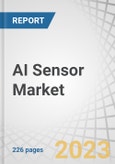The AI sensor market is projected to reach USD 22.1 billion by 2028, from USD 3.0 billion in 2022, at a CAGR of 41.6%. The major opportunities for the AI sensor market include a growing preference for AI sensor-enabled wearables, and advancements in sensor technologies.
Ultrasonic sensors for automotive applications is expected to have largest market size of AI sensor market during the forecast period
Ultrasonic sensors for automotive applications hold the largest market share and are expected to retain their position during the forecast period. With the increasing sales and production of automobiles coupled with the increased customer expenditures, the automotive sector is expected to contribute to the growth opportunities for ultrasonic sensors globally. Ultrasonic sensors offer several applications in the automotive sector, such as parking assistance, safety alarms, collision avoidance, object detection, and automatic braking system. They play an important role in the development of technologies such as driver assistance and self-driving systems.
Machine Learning Technology segment is expected to account for largest market size during the forecast period
The machine learning segment will likely account for the largest market share during the forecast period. This growth is attributed to the enormous availability of data, also called big data. The increasing adoption of machine learning by various sectors, such as financial services, government, healthcare, retail, and oil & gas, enables them to work efficiently to gain an advantage over their competitors in the market. The common applications of machine learning include advertising, computational finance, predictive maintenance, fraud detection, email spam filtering, text processing, network security threat detection, search recommendations, and video analysis.
Germany in Europe is expected to grow with the highest CAGR during the forecast period
Germany is expected to grow with the highest growth rate during the forecast period. Germany is one of the leading countries in Europe in terms of adopting AI and IoT technologies. The German government has also launched several initiatives to support the development and adoption of AI technologies. For instance, the German Federal Ministry for Economic Affairs and Energy has launched the Artificial Intelligence Strategy to promote the use of AI in various sectors, including healthcare, manufacturing, and mobility.
In the process of determining and verifying the market size for several segments and subsegments gathered through secondary research, extensive primary interviews have been conducted with key officials in the AI sensor market. Following is the breakup of the profiles of primary participants for the report.
- By Company Type: Tier 1 - 40 %, Tier 2 - 40%, and Tier 3 - 20%
- By Designation: C-Level Executives - 40%, Directors - 40%, and Others - 20%
- By Region: North America - 40%, Asia Pacific - 30%, Europe - 20% and RoW - 10%
The report profiles key players in the AI sensor market and analyzes their market shares. Players profiled in this report are Teledyne Technologies Incorporated (US), Robert Bosch GmbH (Germany), Goertek Inc. (China), Baidu, Inc. (China), Yokogawa Electric Corporation (Japan), Excelitas Technologies Corp. (US) Hokuriku Electric Industry Co., Ltd. (Japan), Movella Inc. (US), Senodia Technologies (Shanghai) Co., Ltd., STMicroelectronics N.V. (Switzerland), Syntiant Corp. (US), TE Connectivity (US), Alif Semiconductor (US), and Augury (US), Sensata Technologies, Inc. (US), (China), Sensirion AG (Switzerland), Sensortek Technology Corporation (Taiwan), Silicon Sensing Systems Limited (UK), Sony Corporation (Japan), MEMSIC Semiconductor Co., Ltd. (China).
Research Coverage
The report defines, describes, and forecasts the AI sensor market based on type, sensor type, technology, application and region. It provides detailed information regarding factors such as drivers, restraints, opportunities, and challenges influencing the growth of the AI sensor market. It also analyzes competitive developments such as product launches, acquisitions, expansions, contracts, partnerships, and developments carried out by the key players to grow in the market.
Reasons to Buy This Report
The report will help leaders/new entrants in the AI sensor market in the following ways:
1. The report segments the AI sensor market comprehensively and provides the closest market size estimation for all subsegments across regions.
2. The report will help stakeholders understand the pulse of the market and provide them with information on key drivers, restraints, challenges, and opportunities about AI sensor market.
3. The report will help stakeholders understand their competitors better and gain insights to improve their position in the AI sensor market. The competitive landscape section describes the competitor ecosystem.
4. Detailed insights on upcoming technologies, research & development activities, and new product & service launches in the AI sensor market.
5. In-depth assessment of market shares, growth strategies and equipment offerings of leading players like Teledyne Technologies Incorporated (US), Robert Bosch GmbH (Germany), Goertek Inc. (China), Baidu, Inc. (China), among others.
Table of Contents
Companies Mentioned
- Aistorm, Inc.
- Alif Semiconductor
- Augury
- Baidu, Inc.
- Elliptic Laboratories Asa
- Emza Visual Sense Ltd.
- Excelitas Technologies Corp.
- Goertek
- Hokuriku Electric Industry Co. Ltd.
- Keyence Corporation
- Memsic Semiconductor Co. Ltd.
- Movella
- Robert Bosch GmbH
- Senodia Technologies (Shanghai) Co. Ltd.
- Sensata Technologies, Inc.
- Sensirion AG
- Sensortek Technology Corporation
- Silicon Sensing Systems
- Sk Hynix Inc.
- Sony Corporation
- STMicroelectronics N.V.
- Syntiant Corp.
- Te Connectivity
- Teledyne Technologies
- Yokogawa Electric Corporation
Methodology

LOADING...








